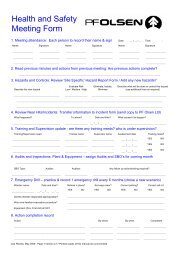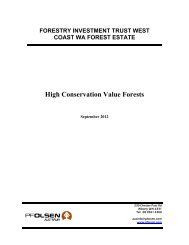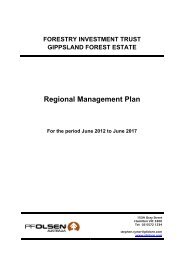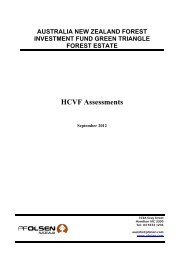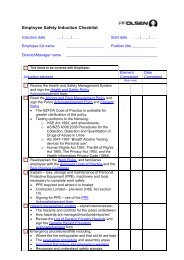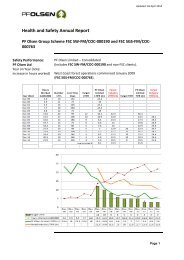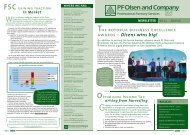Alcohol And Drug Management Policy - PF Olsen Limited
Alcohol And Drug Management Policy - PF Olsen Limited
Alcohol And Drug Management Policy - PF Olsen Limited
Create successful ePaper yourself
Turn your PDF publications into a flip-book with our unique Google optimized e-Paper software.
<strong>Alcohol</strong> and <strong>Drug</strong> <strong>Management</strong> <strong>Policy</strong><br />
Principal<br />
objective and<br />
commitment<br />
<strong>PF</strong> <strong>Olsen</strong> Ltd (<strong>PF</strong> <strong>Olsen</strong>) and its employees and contractors are<br />
committed to creating a workplace free of the impairment associated<br />
with the misuse of alcohol and drugs and to safely achieve its business<br />
objectives. This commitment:<br />
<br />
<br />
<br />
<br />
Promotes individual employee well-being, health and safety.<br />
Creates a work environment where employees feel safe and<br />
supported.<br />
Recognises the importance of satisfying the needs of our clients and<br />
providing a quality service to them.<br />
Improves business performance including the management of<br />
business risk and associated costs.<br />
Initiatives<br />
<strong>PF</strong> <strong>Olsen</strong> will achieve these goals with the following initiatives:<br />
Education, information and training – specialised on-going training<br />
and education will be provided for all employees and contractors to<br />
ensure familiarity with the issues of substance misuse and<br />
impairment, and the policies and the objectives of the company to<br />
maintain a workplace free of the impairment associated with the<br />
misuse of alcohol and drugs.<br />
Pre-employment testing – <strong>PF</strong> <strong>Olsen</strong> offers new appointments<br />
conditional on applicants returning a negative drug test.<br />
Post incident testing – Employees and contractors may be tested for<br />
the presence of drugs or alcohol when they are involved in an<br />
incident and their actions are seen to have contributed to the event.<br />
Reasonable cause testing – Employees and contractors may be tested<br />
for the presence of drugs or alcohol where their actions, appearance,<br />
behaviour or conduct clearly demonstrate that drugs or alcohol may<br />
be impacting on their ability to work effectively and safely.<br />
Random testing for the presence of drugs or alcohol in employees<br />
systems while in the workplace. This testing will apply to employees<br />
that work in „safety sensitive areas‟ only.<br />
Serious misconduct – Employees observed taking, selling, supplying<br />
or being in the possession of drugs or alcohol at work will be<br />
disciplined according to <strong>PF</strong> <strong>Olsen</strong> serious misconduct procedures.<br />
Company funded and voluntary rehabilitation programmes.<br />
This document, signed and dated by the CEO, certifies:<br />
Senior management commitment for this policy<br />
______________________________<br />
<strong>PF</strong> <strong>Olsen</strong> Ltd – CEO Signature<br />
____ / ____ / ____<br />
Date<br />
Last Review: January 2012<br />
Last Modified: June 2012 Printed copies of this manual are uncontrolled Page 1<br />
Version 3.33
Employee<br />
commitment<br />
Every employee of the company is expected to share the Company’s<br />
commitment to an alcohol and drug free workplace – and agrees to<br />
do so by:<br />
<br />
<br />
<br />
<br />
<br />
<br />
<br />
Not reporting for work impaired by substances – legal or illegal<br />
Not taking, selling, supplying or being in the possession of drugs or<br />
alcohol in any <strong>PF</strong> <strong>Olsen</strong> workplace – including operating company<br />
property, equipment and/or vehicles (excluding alcohol at controlled<br />
functions with company management approval).<br />
Attending alcohol and drug education awareness and training as<br />
provided by <strong>PF</strong> <strong>Olsen</strong> from time to time<br />
Voluntarily admitting to rehabilitation as required<br />
Disclosure of all drink-driving convictions accumulated during their<br />
employment with <strong>PF</strong> <strong>Olsen</strong> Ltd<br />
Ensuring that prospective employees comply with this <strong>Alcohol</strong> and<br />
<strong>Drug</strong> <strong>Policy</strong> when it is their responsibility to do so<br />
Taking a mature responsible approach toward legal substances<br />
Employee<br />
agreement<br />
Employees show their agreement with this policy by signing and dating<br />
the Health and Safety section of the Employee Induction form. Signing<br />
this form serves as an acknowledgement that employees have read the<br />
<strong>Alcohol</strong> and <strong>Drug</strong> <strong>Policy</strong>, are committed to its success, and fully<br />
understand their responsibilities.<br />
Privacy statement<br />
All information gathered as a result of drug/alcohol testing is collected<br />
for the purpose of implementing <strong>PF</strong> <strong>Olsen</strong> policy and achieving its<br />
objectives. The Administration Secretary holds this information on the<br />
confidential file and disclosed to the Primary Supervisor and the<br />
Company Health and Safety Manager. Information may be disclosed to<br />
others only with the consent of the employee. The information shall be<br />
destroyed 3 calendar months following termination.<br />
Acknowledgement Employee Acknowledgement<br />
Employee name: Start date: Termination date: Signature:<br />
_______________ ___ / ___ / ___ ___ / ___ / ___ ________________<br />
_______________ ___ / ___ / ___ ___ / ___ / ___ ________________<br />
_______________ ___ / ___ / ___ ___ / ___ / ___ ________________<br />
_______________ ___ / ___ / ___ ___ / ___ / ___ ________________<br />
_______________ ___ / ___ / ___ ___ / ___ / ___ ________________<br />
_______________ ___ / ___ / ___ ___ / ___ / ___ ________________<br />
_______________ ___ / ___ / ___ ___ / ___ / ___ ________________<br />
_______________ ___ / ___ / ___ ___ / ___ / ___ ________________<br />
Last Review: January 2012<br />
Last Modified: June 2012 Printed copies of this manual are uncontrolled Page 2<br />
Version 3.33
About this <strong>Alcohol</strong> and <strong>Drug</strong> <strong>Management</strong> <strong>Policy</strong><br />
Purpose and Aims The purpose of this policy is to address the possibility of our workplace<br />
safety and the safety of our employees being adversely affected by<br />
people who have unacceptable levels of drugs and/or alcohol in their<br />
system. <strong>PF</strong> <strong>Olsen</strong> aims to:<br />
<br />
<br />
<br />
<br />
<br />
Create a workplace free from substance impairment<br />
Ensure <strong>PF</strong> <strong>Olsen</strong> complies with its legal obligations<br />
Recruit only staff who comply with <strong>PF</strong> <strong>Olsen</strong> policies<br />
Provide quality customer service<br />
Support and rehabilitate staff with substance related problems<br />
Scope<br />
This <strong>Alcohol</strong> and <strong>Drug</strong> <strong>Policy</strong> covers the activities of all staff,<br />
contractors employed by:<br />
<br />
<br />
<strong>PF</strong> <strong>Olsen</strong><br />
<strong>PF</strong> <strong>Olsen</strong> Nursery.<br />
Owner<br />
The owner of the <strong>Alcohol</strong> and <strong>Drug</strong> <strong>Management</strong> <strong>Policy</strong> is:<br />
Quality and Health & Safety Manager, <strong>PF</strong> <strong>Olsen</strong> Ltd.<br />
Legislation and<br />
important<br />
references<br />
Health and Safety in Employment Act 1992, and amendments.<br />
The „Plantation Forestry Code of Practice – Eliminating <strong>Drug</strong>s &<br />
<strong>Alcohol</strong> From the Workplace‟ and the associated brochure entitled<br />
„A safe workplace is a drug-free workplace.‟<br />
NZQA Unit Standard 22994 „Demonstrate knowledge of factors that<br />
affect the performance of forestry workers‟<br />
AS/NZS 4308:2008 Procedures for the Collection, Detection and<br />
Quantitation of <strong>Drug</strong>s of Abuse in Urine<br />
AS 3547-1997 “Breath <strong>Alcohol</strong> Testing devices for Personal use”.<br />
Human Rights Act 1993<br />
The Bill of Rights Act 1990<br />
The Privacy Act 1993 and Health Information Privacy Code (1994).<br />
Air New Zealand Judgement: AC 22/04; File No: ARC 42/03<br />
Toll New Zealand Judgement: AC21/07: File No. ARC34/07<br />
Common terms<br />
and acronyms<br />
Adulteration<br />
The forest industry uses a number of common terms and acronyms. To<br />
avoid confusion some are clarified below:<br />
Deliberate use of a dilutent or masking agent, or providing a substitute<br />
urine sample, in order to attempt to “beat” the drug test.<br />
Continued on next page...<br />
Last Review: January 2012<br />
Last Modified: June 2012 Printed copies of this manual are uncontrolled Page 3<br />
Version 3.33
...continued<br />
<strong>Alcohol</strong><br />
<strong>Alcohol</strong> and<br />
drug free<br />
workplace<br />
Certified<br />
Collecting<br />
Agent (CCA)<br />
<strong>Drug</strong>s<br />
GC-MS<br />
Impaired or<br />
substance<br />
impairment<br />
Safety sensitive<br />
Refers to any beverage that contains ethyl alcohol including but not<br />
limited to beer, wine and spirits.<br />
A workplace free from the use, sale, transfer or possession of drugs or<br />
alcohol while on company property or a company worksite (excluding<br />
alcohol at controlled functions with company management approval).<br />
A person who has successfully completed a NZQA unit standard based<br />
training programme for specimen collection, storage, handling and<br />
dispatch in compliance with AS/NZS 4308:2008 or any future updates.<br />
This person may also be trained in conducting breath alcohol tests.<br />
Any drug or substance that cause impairment such as (but not limited to)<br />
cannabis and hashish, opiates (such as heroin and morphine) cocaine and<br />
amphetamines (speed, „P – methamphetamine, ecstasy). The term also<br />
includes misuse of some prescription drugs (e.g. tranquillisers,<br />
sedatives) and legal/illegal party drugs containing e.g. benzylpiperazines<br />
(e.g. Jump, Rapture), and synthetic cannabinoids.<br />
Gas Chromatography - Mass Spectrometry (GC-MS) is the technique<br />
used by testing laboratories to 'confirm' the exact identity and<br />
concentration of drug metabolites in urine.<br />
A person is said to be impaired when they:<br />
<br />
<br />
<br />
Report to a workplace with risk levels of drugs in the system<br />
Report to workplace with a level of alcohol in the system higher than<br />
that defined by the NZ Land Transport Safety Authority (see item 5,<br />
<strong>Alcohol</strong> Testing Procedure).<br />
Have a level of a substance in their system that exceeds AS/NZS<br />
4308:2008 (or any future updates).<br />
Safety sensitive positions are those where there is a significant and<br />
foreseeable risk of injury. <strong>PF</strong> <strong>Olsen</strong> have defined this as:<br />
<br />
<br />
All forest industry tasks, excluding solely administrative positions<br />
Tasks, where serious harm has occurred historically.<br />
Synthetic<br />
Cannabinoids<br />
Workplace(s)<br />
Synthetic cannabinoids are psychoactive herbal and chemical products<br />
which, when consumed mimic the effects of cannabis. As at the 17 th<br />
August 2011 (for one year), it is illegal to manufacture, import, export,<br />
sell, or supply the substances or any product containing them. It should<br />
be noted that possession and use are not criminal offences.<br />
The term „work place‟ refers to all <strong>PF</strong> <strong>Olsen</strong> areas/sites including but not<br />
limited to forests, offices, buildings and plant. „Work place‟ includes the<br />
vehicle being used while driving or being driven to and from a work site.<br />
Last Review: January 2012<br />
Last Modified: June 2012 Printed copies of this manual are uncontrolled Page 4<br />
Version 3.33
Testing Procedures<br />
<strong>Drug</strong> testing<br />
Procedures<br />
The following drug testing procedures will be followed on all occasions:<br />
1. The requirements of the Privacy Act will be strictly adhered to.<br />
2. A consent form will be signed by the employee (Schedule B) or a<br />
consent form will be signed by the applicant (Schedule C).<br />
3. When chain of custody procedures are required: The employee will<br />
be asked to read, sign and date the chain-of-custody agreement<br />
(Schedule F) certifying the specimen is theirs and has not been<br />
changed or altered between the time guardianship (custody)<br />
commenced to the time of the collection.<br />
4. The employee will be able to observe the entire collection,<br />
processing and chain-of-custody procedure of the specimen,<br />
including the splitting of the sample into two bottles.<br />
5. Urine specimens shall be taken by an certified collecting agent and<br />
either screened using a verified on-site device or tested at an<br />
approved accredited laboratory in accordance with AS/NZS<br />
4308:2008 (or any future updates).<br />
6. A „non negative‟ screen will only be reported „positive‟ by the<br />
testing facility if GCMS or LCMS confirms the level of a drug or<br />
metabolite, which is equal to or above the confirmation cut-off level<br />
tabulated later this section.<br />
7. Employees returning a „non negative‟ screen will be immediately<br />
removed from all Safety Sensitive work.<br />
8. Employees confirming a „positive‟ test continue „stood down‟ until a<br />
negative test is completed; rehabilitation shall commence.<br />
<strong>Alcohol</strong> testing<br />
procedure<br />
The following alcohol testing procedures will be followed on all<br />
occasions:<br />
1. The requirements of the Privacy Act will be strictly adhered to.<br />
2. A consent form will be signed by the applicant (Schedule C) or the<br />
existing employee (Schedule D)<br />
3. When chain of custody procedures are required: The employee will<br />
be asked to read, sign and date the chain-of-custody statement<br />
(Schedule F) certifying the sample provided has not been changed or<br />
altered between the times guardianship (custody) commenced to the<br />
time of the collection.<br />
4. Breath alcohol tests will be conducted using an Approved Testing<br />
Device, which meets the Australian Standard: AS 3547-1997.<br />
5. The threshold levels are the Land Transport (Road Safety and Other<br />
Matters) Amendment Act 2011 limits for breath alcohol tolerance; to<br />
not exceed any level of alcohol above 400 micrograms of alcohol per<br />
litre of breath (over 20 years of age) or above „0‟ micrograms of<br />
alcohol per litre of breath (under 20 years of age). Results in excess<br />
of these denote a non negative test.<br />
Continued on next page...<br />
Last Review: January 2012<br />
Last Modified: June 2012 Printed copies of this manual are uncontrolled Page 5<br />
Version 3.33
...continued<br />
6. NB: If the test is in excess of the tolerance, a witness is needed for a<br />
confirmatory alcohol test. If the confirmatory test shows positive,<br />
both the CCA and the witness shall sign the result, because the result<br />
of this test is final.<br />
7. Employees returning a „positive‟ test will be immediately removed<br />
from all Safety Sensitive work. Rehabilitation shall commence.<br />
Random testing<br />
Random testing provides a mechanism to ensure the workplace remains<br />
free from persons impaired by alcohol and/or drugs.<br />
The selection process, completed by a third party, will ensure a random<br />
selection of candidates. Every person in the pool of candidates will have<br />
an equal chance for testing (target rate = 50% of the population).<br />
Following selection, the testing process outlined in Schedule G will be<br />
used.<br />
Reasonable Cause<br />
testing<br />
Reasonable cause testing provides a mechanism to test employees when<br />
there is good reason to believe an accident or incident or a persons<br />
behaviour has resulted or is the result of the presence of alcohol and/or<br />
drugs in that employees system.<br />
Reasonable cause and post accident/incident testing must be based on<br />
observation. The evaluation procedure, that analyses the employees<br />
behaviour, attitude and conduct will be used before and reasonable<br />
cause test in conducted. This procedure is outlined in Schedule A will<br />
be used.<br />
Following the „schedule A‟ procedure, the testing process outlined in<br />
Schedule G will be used.<br />
Employee refuses<br />
testing<br />
The right to test employees is well founded in New Zealand law. For<br />
example: AC22/04 ARC 42/03 Air New Zealand vs. Combined Trade<br />
Unions (6 unions) accepted that… „The Employer has the right to<br />
manage its business as it sees fit...‟ (4) also that the Employer not only<br />
„may but must monitor employees for the purpose of ascertaining<br />
whether they are or could be a cause of harm to themselves or any other<br />
person…‟ (247)<br />
Where an employee refuses to undergo a test, the refusal shall be treated<br />
under the serious misconduct procedures in <strong>PF</strong> <strong>Olsen</strong> rules and<br />
appropriate disciplinary procedures will be applied.<br />
Last Review: January 2012<br />
Last Modified: June 2012 Printed copies of this manual are uncontrolled Page 6<br />
Version 3.33
Education and<br />
training<br />
From time to time, educational on the implications of the <strong>Drug</strong> &<br />
<strong>Alcohol</strong> policy, the drug testing options, and the manner in which drug<br />
and alcohol tests, and how to access professional drug and alcohol<br />
treatment/ counselling will be made available to all employees. The<br />
primary source of guidance is The „Plantation Forestry Code of Practice<br />
– Eliminating <strong>Drug</strong>s & <strong>Alcohol</strong> From the Workplace‟ and the associated<br />
brochure entitled „A safe workplace is a drug-free workplace.‟<br />
Attendance is compulsory for all <strong>PF</strong> <strong>Olsen</strong> <strong>Limited</strong> employees.<br />
Emergency<br />
situations<br />
Where it is not practical for a test to be carried out immediately due to<br />
the injuries to the employee or other corrective actions:<br />
First, attend to the other corrective actions<br />
Ensure the chain of custody is not broken. (Schedule F)<br />
Carry out the testing at the first appropriate opportunity.<br />
Serious Misconduct<br />
Serious<br />
misconduct<br />
The serious misconduct company rule will apply where:<br />
1. An employee is observed taking, selling, supplying, or being in<br />
possession of drugs or alcohol at work (other than alcohol at <strong>PF</strong><br />
<strong>Olsen</strong> controlled functions with management approval). This may<br />
result in summary dismissal.<br />
2. An employee refuses to take a test and there is documented evidence<br />
(minimum two persons using Schedule A) that the employee<br />
displays the behaviours of someone substance impaired.<br />
3. An employee refuses to take a test (being part of the Company<br />
Random Testing programme) and the employee is engaged in or is<br />
required to engage in „Safety Sensitive‟ work.<br />
NB: Any employee refusing a test will not be able to undertake „Safety<br />
Sensitive‟ work until such time as a negative result is produced.<br />
Last Review: January 2012<br />
Last Modified: June 2012 Printed copies of this manual are uncontrolled Page 7<br />
Version 3.33
Procedure<br />
1. The Primary Supervisor must conduct an investigation into the<br />
incident as soon as possible, including questioning the complainant,<br />
witnesses and the employee.<br />
2. The employee has the right to have a representative present. If the<br />
complaint appears substantive the employee will be suspended on<br />
pay and advised that a disciplinary hearing will be convened.<br />
3. The employee will be formally advised of the date of the<br />
disciplinary meeting and that the outcome could be dismissal. The<br />
employee shall be advised about the right to have a representative<br />
present.<br />
4. At the meeting the Primary Supervisor and the Company Health and<br />
Safety Manager must present the facts as they have collected them<br />
and the employee must be allowed to answer and explain any<br />
allegations. The employee must be advised in writing of the<br />
conclusions reached and disciplinary action to be taken.<br />
5. All investigations, discussions, advice of meetings and minutes must<br />
be recorded in writing and held on the confidential file.<br />
Rehabilitation<br />
General<br />
Any employee of the company that returns a „non-negative‟ screen or a<br />
confirmed „positive‟ test shall not perform „Safety Sensitive‟ work until<br />
a negative test result is achieved.<br />
If they wish to continue employment with the Company, they shall<br />
undertake rehabilitation. The employee may be required to initiate his or<br />
her own rehabilitation including any follow-up testing. Sessions shall be<br />
taken outside work hours or leave entitlements may be taken.<br />
The Company has a preference for „voluntary rehabilitation‟ –<br />
Voluntary (or self) admittance is, in most cases, free to New Zealand<br />
citizens. Additionally, „voluntary rehabilitation‟ is in keeping with the<br />
philosophy that people „that need to change‟ must first „want to change.‟<br />
The employee must sign a contract stating that they have enrolled<br />
thereby agreeing to the programme and to follow up testing (see<br />
Schedule E). NB: This contract allows information, concerning their<br />
progress, to flow back to appropriate servants of the Company.<br />
Failure to take part or complete the programme, as per the contract, may<br />
result in disciplinary action including dismissal.<br />
Any employee may voluntary join rehabilitation at any time and <strong>PF</strong><br />
<strong>Olsen</strong> will not enquire of facts relating to rehabilitation unless the<br />
Voluntary Rehabilitation Agreement (see Schedule E) has been signed.<br />
Last Review: January 2012<br />
Last Modified: June 2012 Printed copies of this manual are uncontrolled Page 8<br />
Version 3.33
Company funded<br />
rehabilitation<br />
<strong>PF</strong> <strong>Olsen</strong>, at its sole discretion, may fund rehabilitation according to the<br />
following procedure:<br />
1. Employee must sign a contract agreeing to the programme and<br />
follow up testing (see Schedule E). NB: The contract allows<br />
information, concerning the progress, to flow back to appropriate<br />
servants of the Company.<br />
2. The Company Health and Safety Manager will arrange an initial<br />
appointment for the employee to meet with the Substance Abuse<br />
Specialist (SAS)<br />
3. The employee will be given contact details of the SAS.<br />
4. Communications between the SAS, the employer and employee are<br />
confidential<br />
5. The SAS will arrange for treatment or further specialist advice as<br />
considered necessary<br />
6. The SAS will advise the manager if an alternative (non Safety<br />
Sensitive) employment situation would be advisable in the interim<br />
7. Rehabilitation will commence and the rehabilitation provider will<br />
provide the Company Health and Safety Manager with information<br />
on the attendance of the employee<br />
8. The SAS will report to the Company Health and Safety Manager<br />
after the agreed to number of sessions on the necessity or value of<br />
further treatment<br />
9. The employee may be required to fund additional sessions required<br />
beyond those provided by <strong>PF</strong> <strong>Olsen</strong>.<br />
Follow-up testing<br />
The employee will be subject to up to six unannounced follow-up drugs<br />
and/or alcohol tests during and after rehabilitation. Any testing, relative<br />
to this round of rehabilitation, must be completed within the following 2<br />
years. Any subsequent positive test within the 2-year period may result<br />
in disciplinary action including dismissal.<br />
Last Review: January 2012<br />
Last Modified: June 2012 Printed copies of this manual are uncontrolled Page 9<br />
Version 3.33
Confirmatory Test Cut-Off Levels for <strong>Drug</strong>s – AS/NZS 4308:2008<br />
Compound<br />
Morphine<br />
Codeine<br />
6-Acetylmorphine*<br />
Amphetamine<br />
Methylamphetamine<br />
Methylenedioxymethamphetamine<br />
Methylenedioxyamphetamine<br />
Benzylpiperazine*<br />
Phentermine*<br />
Ephedrine*<br />
Pseudoephedrine<br />
11-nor- 9- tetrahydrocannabinol-carboxylic acid<br />
All Synthetic Cannabinoid Compounds<br />
Benzoylecgonine<br />
Ecgonine methyl ester<br />
Oxazepam<br />
Temazepam<br />
Diazepam<br />
Nordiazepam<br />
Alpha-hydroxy-alprazolam<br />
7-amino-clonazepam<br />
7-amino-flunitrazepam<br />
7-amino-nitrazepam<br />
Cut-off level<br />
# (ng/mL)<br />
300<br />
300<br />
10<br />
150<br />
150<br />
150<br />
150<br />
500<br />
500<br />
500<br />
500<br />
15<br />
10<br />
150<br />
150<br />
200<br />
200<br />
200<br />
200<br />
100<br />
100<br />
100<br />
100<br />
* These drugs may be optionally tested within each class and the specified cut-off concentrations shall apply.<br />
# All cut-off levels are expressed as total concentration of drug or metabolite after hydrolysis of conjugates.<br />
Test Cut-Off Concentrations for <strong>Alcohol</strong> – AS 3547:1997<br />
Those set by the Land Transport New Zealand for legal drink<br />
driving and the Land Transport (Road Safety and Other Matters)<br />
Amendment Act 2011<br />
For people over twenty years of age<br />
For people under twenty years of age<br />
Cut-off level<br />
#(micrograms/litre of<br />
breath)<br />
400<br />
0<br />
Last Review: January 2012<br />
Last Modified: June 2012 Printed copies of this manual are uncontrolled Page 10<br />
Version 3.33
Schedule A – Reasonable Cause Indicators and Observations<br />
Assessing<br />
When assessing for reasonable cause, there will usually be more than<br />
one indicator present. Examples of reasonable cause include, but are not<br />
limited to the following:<br />
Indicators – note down observations, dates and times Date Time Date Time<br />
Excessive lateness<br />
Absences often on Monday, Friday or in conjunction with holidays<br />
Increased health problems or complaints about health<br />
Emotional signs – outbursts – anger, aggression<br />
Changes in personality from previous history<br />
Changes in alertness – difficulty with attention span<br />
Changes in appearance – clothing, hair personal hygiene<br />
Less energy or a sudden unexplained drop in performance<br />
Involvement in various minor accidents<br />
Feigning sickness or emergencies to get out of work early<br />
Going to vehicle, smoko hut, the bathroom more than necessary or normal<br />
Defensive when confronted about behaviour – violent<br />
Dizziness or disorientation, impaired judgement of distance/objects<br />
Slow or slurred speech,<br />
Hangovers<br />
Sudden, violent behaviour – high energy levels<br />
Impaired motor skills, slow gait<br />
Bloodshot eyes, fully dilated pupils, constricted pupils, stuffy nose,<br />
Impaired or reduced short term memory<br />
Reduced ability to perform tasks requiring concentration and co-ordination<br />
Intense anxiety or panic attacks<br />
Impairments in learning and memory, perception and judgement<br />
Irritability<br />
Depression – concern expressed by fellow workmates<br />
Employee observed:<br />
Comments:<br />
Manager Signature:<br />
Witness Signature:<br />
It is important to document actual „observations‟. Tick the behaviour<br />
observed and mark the date and time of the observation made. Have a<br />
witness sign this form. Hold the form on confidential file.<br />
Last Review: January 2012<br />
Last Modified: June 2012 Printed copies of this manual are uncontrolled Page 11<br />
Version 3.33
Schedule B – Existing Employee, Consent for <strong>Drug</strong> Testing<br />
I consent to undergo a drug test, to be undertaken by a certified collecting agent (CCA) and<br />
a confirmatory test to be undertaken by a an accredited laboratory, both appointed by <strong>PF</strong><br />
<strong>Olsen</strong> Ltd. I acknowledge these tests are to determine whether illicit or restricted drug(s) or a<br />
misused prescribed drug(s) present in my urine, at concentrations higher than the accepted<br />
international standard as defined by the AS/NZS 4308:2008.<br />
I understand that a urine sample will be collected and the drugs being tested for are<br />
cannabinoids, opiates, amphetamine-type substances (including benzylpiperazine), cocaine,<br />
benzodiazepines, (and others if applicable).<br />
<strong>PF</strong> <strong>Olsen</strong> Ltd undertakes that the result of the test will be used only for the purpose for which<br />
they were obtained, and that any collection, storage or exchange of medical information<br />
concerning the test will be in accordance with the Privacy Act.<br />
I undertake to advise the CCA collecting my urine of any medication that I am taking. I also<br />
agree to provide the collecting agent with photograph identity, if required to do so.<br />
I consent to the results of the drug test(s) being communicated confidentially to the authorised<br />
representative of <strong>PF</strong> <strong>Olsen</strong> <strong>Limited</strong>.<br />
I understand that I may request a second confirmatory test be conducted on the „duplicate<br />
specimen‟ and analysed within 14 days of receiving the result. For the second test to be „nonnegative‟<br />
there need only be the presence of drug or metabolite detected (i.e. not cut off<br />
limits). This will be accepted as a conclusive result and costs associated with this test will be<br />
borne by me. If the second test proves negative this will be accepted as a conclusive result and<br />
<strong>PF</strong> <strong>Olsen</strong> Ltd will reimburse costs associated with this test.<br />
I understand that a refusal to sign this form for the drug test, or the return of a non-negative<br />
result means the <strong>PF</strong> <strong>Olsen</strong> Ltd disciplinary procedure for serious misconduct will follow and<br />
that I will be required to voluntarily join rehabilitation. In the case of an internal transfer, the<br />
job offered/applied for will not be confirmed or offered to me.<br />
I have read this consent form, or have had it explained to me, and I understand its contents.<br />
Employee‟s signature __________________________________ Date ___ / ___ / ___<br />
Employee‟s name<br />
__________________________________<br />
CCA signature __________________________________ Date ___ / ___ / ___<br />
CCA name<br />
__________________________________<br />
Tick those that apply:<br />
( ) Negative ( ) Non-negative<br />
( ) Reasonable cause ( ) Post incident ( ) Internal transfer<br />
( ) Random ( ) Rehabilitation follow-up<br />
Last Review: January 2012<br />
Last Modified: June 2012 Printed copies of this manual are uncontrolled Page 12<br />
Version 3.33
Schedule C – Job Applicant, Consent for <strong>Drug</strong> and <strong>Alcohol</strong> Testing<br />
I consent to undergo a drug test to be undertaken by a certified collecting agent (CCA) and<br />
an accredited laboratory appointed by <strong>PF</strong> <strong>Olsen</strong> Ltd and an alcohol 1 breath test to be<br />
conducted by a person trained in the use of an approved breath testing device.<br />
I acknowledge these tests are to determine whether illicit or restricted drug(s) or a misused<br />
prescribed drug(s) present in my urine, at concentrations higher than the accepted<br />
international standard as defined by the AS/NZS 4308:2008. I understand that the drugs being<br />
tested for are cannabinoids, opiates, amphetamine-type substances (incl. benzylpiperazine),<br />
cocaine, benzodiazepines, (and others if applicable). Also, to determine whether I have a level<br />
of alcohol in my breath above 400 micrograms of alcohol per litre of breath (over 20 years of<br />
age), or above 0 micrograms of alcohol per litre of breath (under 20 years of age).<br />
<strong>PF</strong> <strong>Olsen</strong> Ltd undertakes that the results of the tests will be used only for the purpose for<br />
which they were obtained, and that any collection, storage or exchange of medical<br />
information concerning the test will be in accordance with the Privacy Act.<br />
I undertake to advise the CCA collecting my urine of any medication that I am taking. I also<br />
agree to provide the collecting agent with photograph identity, if required to do so.<br />
I consent to the results of the drug test(s) being communicated confidentially to the authorised<br />
representative of <strong>PF</strong> <strong>Olsen</strong> <strong>Limited</strong>. I understand that the decision whether or not to employ<br />
me will be based on many factors, including testing results, and that <strong>PF</strong> <strong>Olsen</strong> Ltd is not<br />
required to explain the basis for it‟s decision. I may request a copy of my results.<br />
I understand that I may request a second confirmatory test be conducted on the „duplicate<br />
specimen‟ and analysed within 14 days of receiving the result. For the second test to be „nonnegative‟<br />
there need only be the presence of drug or metabolite detected (i.e. not cut off<br />
limits). This will be accepted as a conclusive result. I reserve the right to waiver a second<br />
confirmatory and do so by signing here________________________________________.<br />
I have read this consent form, or have had it explained to me, and I understand its contents.<br />
Applicant‟s signature ______________________________ Date ___ / ___ / ___<br />
Applicant‟s name<br />
______________________________<br />
CCA signature ______________________________ Date ___ / ___ / ___<br />
CCA name<br />
______________________________<br />
Witness signature ______________________________ Date ___ / ___ / ___<br />
Witness name ______________________________ Reading ____________<br />
Tick those that apply: <strong>Drug</strong>s ( ) Negative ( ) Non-negative<br />
Breath alcohol ( ) Negative ( ) Non-negative<br />
1 A witness is needed for a confirmatory alcohol test, because the result of the test is final. The witness shall<br />
record the reading.<br />
Last Review: January 2012<br />
Last Modified: June 2012 Printed copies of this manual are uncontrolled Page 13<br />
Version 3.33
Schedule D – Existing Employee, Consent Breath <strong>Alcohol</strong> Testing<br />
I consent to undergo a breath alcohol test, which I acknowledge is to determine whether I<br />
have alcohol in my breath at levels higher than those set out in the <strong>PF</strong> <strong>Olsen</strong> Ltd drug and<br />
alcohol policy.<br />
<strong>PF</strong> <strong>Olsen</strong> Ltd undertakes that the result of the test will be used only for the purpose for which<br />
they were obtained, and that any collection, storage or exchange of medical information<br />
concerning the test will be in accordance with the Privacy Act.<br />
I understand that the test(s) are to determine whether I have a level of alcohol in my breath<br />
above 400 micrograms of alcohol per litre of breath (over 20 years of age), or above 0<br />
micrograms of alcohol per litre of breath (under 20 years of age).<br />
I understand that a refusal to sign this form, undergo a breath test, or the return of a nonnegative<br />
alcohol test result means the <strong>PF</strong> <strong>Olsen</strong> Ltd disciplinary procedure for serious<br />
misconduct will follow and that I will be required to voluntarily join rehabilitation. In the case<br />
of an internal transfer, the job offered/applied for will not be confirmed or offered to me.<br />
I hereby authorise the collection and testing of a breath sample for alcohol.<br />
I consent to the results of the drug test(s) being communicated confidentially to the authorised<br />
representative of <strong>PF</strong> <strong>Olsen</strong> <strong>Limited</strong>.<br />
I have read this consent form, or have had it explained to me, and I understand its contents.<br />
Applicant‟s signature ______________________________ Date ___ / ___ / ___<br />
Applicant‟s name<br />
______________________________<br />
CCA signature ______________________________ Date ___ / ___ / ___<br />
CCA name<br />
______________________________<br />
Witness signature ______________________________ Date ___ / ___ / ___<br />
Witness 1 name ______________________________ Reading ____________<br />
Tick those that apply: <strong>Drug</strong>s ( ) Negative ( ) Non-negative<br />
Breath alcohol ( ) Negative ( ) Non-negative<br />
1 A witness is needed for a confirmatory alcohol test, because the result of the test is final. The witness shall<br />
record the reading.<br />
Last Review: January 2012<br />
Last Modified: June 2012 Printed copies of this manual are uncontrolled Page 14<br />
Version 3.33
Schedule E – Voluntary Rehabilitation Agreement<br />
I acknowledge that I have voluntarily joined rehabilitation and that my continued employment<br />
with <strong>PF</strong> <strong>Olsen</strong> Ltd is subject to the following:<br />
I am committed to full participation in a „Rehabilitation <strong>Management</strong> Plan‟ (drug and/or<br />
alcohol assessment, treatment and case management) with a service provider(s) suitable to<br />
<strong>PF</strong> <strong>Olsen</strong> Ltd.<br />
I authorise the service provider to release the following information to <strong>PF</strong> <strong>Olsen</strong> Ltd, as and<br />
when required by the company:<br />
1. Whether I have kept appointments<br />
2. Whether the service provider has recommended a course of treatment<br />
3. Whether I am following that course<br />
4. Whether a return to work is appropriate and within what timeframe<br />
5. Whether I can work in a safety sensitive area<br />
6. Whether I have completed the required treatment<br />
7. Whether return to work is to full or alternative duties<br />
I agree to take this course outside work hours or use leave entitlements if required to<br />
participate during work hours.<br />
I agree to be subject to up to six unannounced follow-up drugs and/or alcohol tests during and<br />
after rehabilitation. Testing, relative to this round of rehabilitation will be completed within 2<br />
years of the date on the bottom of this form.<br />
I accept that if:<br />
<br />
<br />
<br />
I do not attend or complete the required course<br />
On any future occasion, including the tests above, I return a positive test<br />
I refuse to take any of the subsequent tests the consequence may be dismissal without<br />
notice.<br />
I accept the terms of this agreement, which I acknowledge may be in addition to the terms of<br />
my current employment agreement and agree to be bound by both contracts.<br />
Employee‟s signature __________________________________ Date ___ / ___ / ___<br />
Employee‟s name<br />
__________________________________<br />
Witness signature __________________________________ Date ___ / ___ / ___<br />
Witness name<br />
__________________________________<br />
Last Review: January 2012<br />
Last Modified: June 2012 Printed copies of this manual are uncontrolled Page 15<br />
Version 3.33
Schedule F – Chain of Custody Agreement<br />
Section 1 – Custodian statement and warranties<br />
I ______________________________________ (Full name of employee), acting as<br />
custodian, am employed by <strong>PF</strong> <strong>Olsen</strong> Ltd and act in the capacity of [Health and Safety<br />
Representative /custodian – or similar] for the Company.<br />
I have received training in chain of custody procedures as they relate to the management of<br />
the <strong>PF</strong> <strong>Olsen</strong> Ltd <strong>Alcohol</strong> & <strong>Drug</strong> <strong>Policy</strong> and <strong>Management</strong> Plan.<br />
I am the custodian, solely as it relates to the management of <strong>PF</strong> <strong>Olsen</strong> Ltd <strong>Alcohol</strong> & <strong>Drug</strong><br />
<strong>Policy</strong> for ______________________________________ (Full name of employee<br />
undergoing tested – henceforth known as the employee). I warrant that the employee I have in<br />
my custody is the same person completing and signing section 2 of this form.<br />
I warrant that I have accompanied the employee to the <strong>PF</strong> <strong>Olsen</strong> Ltd approved specimen<br />
collecting agent. I further warrant that there has been no opportunity for the employee to<br />
consume drugs or alcohol between the times guardianship (custody) commenced and when<br />
the employee provided the sample/specimen to the collection agent.<br />
Section 2 – Employee warranties<br />
I ______________________________________ (Full name of employee undergoing testing<br />
– henceforth known as the employee) am the subject of these proceedings.<br />
I warrant that the (sample of breath provided / the specimen of urine provided) is mine and<br />
that it has not been changed or altered between the times guardianship (custody) commenced<br />
to the time of providing the sample/specimen to the collection agent.<br />
Employee‟s signature __________________________________ Date ___ / ___ / ___<br />
Employee‟s name<br />
__________________________________<br />
Custodian signature __________________________________ Date ___ / ___ / ___<br />
Custodian name<br />
___________________________________<br />
Last Review: January 2012<br />
Last Modified: June 2012 Printed copies of this manual are uncontrolled Page 16<br />
Version 3.33
Schedule G – Testing Flowchart<br />
Front end – i.e. reason for testing process:<br />
Pre-employment – when applicant approved →<br />
Post-incident (RC) – follows incident analysis →<br />
Random – when employee group is selected →<br />
Refuses to<br />
take test<br />
Employee or<br />
approved job<br />
applicant asked to<br />
take test<br />
Random<br />
screen<br />
administered<br />
Agrees and signs appropriate consent form<br />
Person accompanied to<br />
Collection centre →<br />
← Agents vehicle<br />
Pre-employment,<br />
Post Incident or<br />
Reasonable Cause<br />
(RC) screen<br />
administered<br />
Disciplinary<br />
procedure for<br />
employee – stood<br />
down until<br />
employee<br />
produces negative<br />
test.<br />
Person stood down<br />
from work,<br />
confirmatory lab<br />
evaluation<br />
completed<br />
Test results<br />
received by<br />
Manager<br />
Pre-employment<br />
candidates with a<br />
positive test not<br />
awarded job<br />
Not rehabilitated<br />
or doesn‟t want to<br />
be rehabilitated<br />
Non-negative<br />
___________________________________________________________<br />
Positive results<br />
Person informed<br />
of results by<br />
Manager<br />
Disciplinary<br />
Interview<br />
Negative result<br />
Rehabilitation<br />
declined<br />
Agrees to<br />
rehabilitation,<br />
signs agreement &<br />
commences<br />
rehabilitation<br />
Rehabilitation and<br />
subsequent testing<br />
at random (3 pa)<br />
Employee returns<br />
to work,<br />
rehabilitation<br />
process continues,<br />
Applicant<br />
continues in<br />
employment<br />
process<br />
END<br />
Last Review: January 2012<br />
Last Modified: June 2012 Printed copies of this manual are uncontrolled Page 17<br />
Version 3.33



